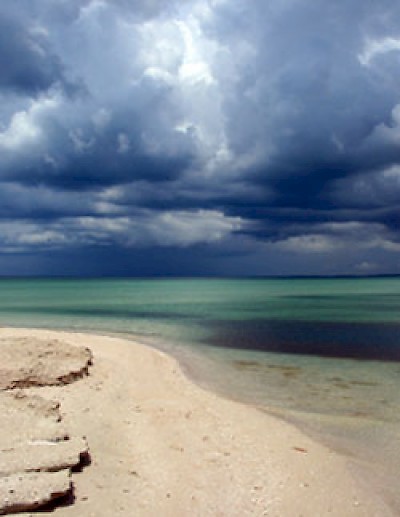New Yucatan Beach Law
Though we don't own property on the beach, we know lots of people who do or who want to! So when we heard about the law that was passed this last summer that prevents building within a certain distance from the Federal property line on the local Yucatan Gulf Coast beaches, we were mildly concerned. We asked some of our real estate acquaintances what they knew and what they thought about this new law.
Mitch Keenan, owner of Mexico International Real Estate, was on his way to the States when we asked him about it, with the text of this law as his reading material. He has promised a report back after reading it and discussing it with various colleagues familiar with Mexican laws.
Jennifer Lytle, owner of Tierra Yucatan and recently featured on our Yucatan Living Interviews, has this to say:
On July 21st on the afternoon he was leaving office, the outgoing Governor of Yucatan Patricio Patron Laviada passed a new law for the protection of the coastline. Studies had been ongoing for a number of years looking for recommendations to prevent further coastal erosion, to protect flora and fauna in sensitive breeding grounds, and to conserve the aquifers which provide most of Yucatan's fresh water.
This law consists of 96 pages of fine print, dividing the coastal areas from Celestun to San Felipe into many coded areas and assigning designations to each as to what can be built there and how.
It seems not to affect existing property in already developed urban areas, but will affect new construction along most of the coast. Exactly how it affects new construction will depend on the exact geographic coordinates of the property and varies widely from case to case. For those owning property, we will be happy to give you the exact details pertaining under the law if you will provide the coordinates.
In most areas, it will be possible to build on any lot of any size, provided the construction is raised above the ground on pilings at least 1.5 meters high to allow the free passage of water and wildlife on the beach. You may not destroy dunes or remove native plants, and where this has been done, the law requires that you help replant and rebuild the dunes.
In some areas, any new construction must be more than 60 meters from high tide - or 40 meters from the federal zone, and there are also restrictions on the percentage of land which may be covered by construction - varying from 10% to 20% in more isolated areas. There are certain height restrictions, but I must emphasize again that there are no general answers - everything depends on the exact location.
>
As far as implementation, as yet there is no specific authority in charge and the local people here are only just beginning to be aware that the law even exists. It is not being enforced, and construction, renovation and rebuilding is continuing without any modification. I am told that citizens groups are beginning to put forward constitutional challenges to the law, as if it is enforced it will have far-reaching effects on the value of property and especially land on the coast of Yucatan. I personally believe the law will soon be rescinded or greatly modified, as too many interests are at risk. As soon as I have more news, I will write an update. We are all anxiously waiting for clarification from the current state government.
Update as read in the Diario de Yucatan, October 15:
Decreto 801 Will be Modified: After the Commission of Evaluation and Continuity of the Committee of Ecological Regulation, which will occur in the next 15 days, spaces will be opened for public consultation destined to modify this disposition, which currently prohibits reconstruction and giving maintenance to houses that are less than 60 meters from the beach. On October 19, the Committee of Ecological Regulation will meet, for the purpose of installing the Commission of Evaluation and Continuity that will modify Decreto 801. This commission will open space for public comment, opinions, and revisions of everything relevant to the decree, indicated Eduardo Batlori Sampedro, head of the state Secretariat of Ecology.
So there you have it. Stay tuned to Yucatan Living for further updates as we have them.










Comments
CasiYucateco 16 years ago
Note:
This law consists of 96 pages of fine print, dividing the coastal areas from Celestun to San Felipe into many coded areas and assigning designations to each as to what can be built there and how.
Sisal is between Celestun and San Felipe. Note that the generally accepted maximum size of a Fideicomiso-held lot is 2000 sq meters and be prepared for additional legal hoops when trying to buy something larger for residential property.
Reply
CasiYucateco 16 years ago
Do lots of investigating before buying anything, anywhere, but most particularly in a foreign country. Be sure you get competent - Independent, Competent - legal advice. Be sure you have someone representing your best interests, not someone who stands to gain from your purchase, who is advising you. Even better, visit and see how many houses are standing in any development, anywhere, and what the prospects are for the development to be 'built out.'
If you do your due diligence for yourself, you'll end up happy... most likely.
Reply
Kathy 16 years ago
I'm also interested in Sunset Shores, as John is and don't seem to see a reply from anyone to whether this area has restrictions or not. Also I'm guessing this law only pertains to persons who purchase beach property, and not perhaps a back lot?
Reply
17 years ago
At least they're making an effort at conservation. I hope they have the strength to enforce.
Reply
Joaquin De la Gala 17 years ago
I´m deeply suggested before make any closing for a beachfront property try to get an opinion from SEMARNAT. Just remember, any way ,you will need a Envorimental Impact Studie before you begin to build , in that Studie the Federal Authorities will authorized to You according to the State and Federal regulations allowed.
I think that if You will be worried for some envorimental matter dont lost your time in this matter , be carefull about the property dont have any area with mangrove, there is a new Federal Law about it, more estrictly as the Yucatan Coast Program.
I will be glad to help any one who are interested in Sisal area.
Reply
John 17 years ago
This is really an interesting issue. I am considering a lot at Sunset Shores East of Sisal. Does anyone know what restrictions are proposed for that area?
Reply
Mikey 17 years ago
Many Thanks for the information. We have a beachfront house between Chelem & Chuburna, I wonder whether this is in the specific region? Presumably hurricane insurance is worthless? I agree with malcolm.
Reply
Yucatan Living - More on Yucatan’s Descreto 801 Law 17 years ago
[...] As Jennifer Lytle mentioned earlier, the coast is divided into many regions and each has specific [...]
Reply
Malcolm 17 years ago
I am perhaps pathologically not worried about this. Here's my take, as posted on Merida Insider:
I'm not worried about this, and, living full-time three meters from the water, I'm sure some will think I should be. But I'm not. And I'm certainly not signing any weird misspelled petitions. Here's why:
1. I am not a Mexican, and have no business meddling in local politics. First, it's illegal. Second, it's ineffectual. No one cares what me and my house in Chelem have to say about it. We have already read in these pages that over 400 beach owning Mexican families are on the case, and they (and their money) are going to carry a whole lot more weight than a bunch of extranjeros having fits.
2. As noted here in an article thankfully translated by Dug, the law is already scheduled for review and revision on October 19th, and large portions of it have been declared unconstitutional. As outlined in item one, the proper people have made the proper stink, and hopefully that will be that. If not, expect more stink.
3. Permits and enforceability. This law is utterly unenforceable. You can't swing a cat around here without finding someone willing to build you whatever you want, wherever you want, permits or no.
Look, I don't want to see my property values decline or my house destroyed. And I certainly don't think this is all part of some big scary Pemex conspiracy. But based on the lawyers and architects I've spoken with, I just don't see this one standing for long...and the outcome, one way or the other, is going to have little to do with my personal panic levels. Relax.
Reply
CasiYucatecan 17 years ago
This is the first I've heard of the new law, so many thanks go to the Working Gringos for helping us keep up. Like you, I do not own property on the beach, but many do, including some friends.
From your description of the law, it sounds like it fits directly into the currently accepted views of beach preservation elsewhere in the world. The dunes and indigenous plants are key to preserving the balance between land and sea. We've seen areas where new houses are being built and plants are simply wiped out, then the house planted far from the access road end of the lot, i.e., close to the sea. Without the plants and dunes, erosion will inevitably set in. Many claim it does not, but it does.
Sand is constantly pushed and pulled by the sea, wind, gravity. Dunes are a reservoir of sand. The plants hold it in place. Without these, there is no reserve. A slow - or fast - depletion of beach results. If new houses were beyond the dunes (back from the sea), the plants protected and only a narrow winding path cleared (or better yet, a raised boardwalk as found in many places on the east coast of the USA, the beach would remain for the new homeowners to enjoy. A few extra steps to walk seems a small price to pay for preserving everyone's beach.
Another direct cause of erosion is the solid rock-fill pier extending out from the older arched bridge pier at Progreso. Satellite photos clearly show a swirling pattern in the water on either side of the pier, depending on the season. This diversion and intensification of the currents scours the beaches. Dredging out the shipping channel provides a place for the sand to slide down to, speeding the process. Although astronomically higher in cost, an extension of the pier with arches allowing the water to mostly pass through would have been a wiser long-term choice. As it is, sand will have to be trucked or pumped up to the Progreso beach, forever.
Reply
Yucatan Gringos » Archive » Decreto 801 and global warming 17 years ago
[...] it will either be overturned or rewritten. . .for a more thorough review read the latest report in Yucatan Living. [...]
Reply
« Back (30 to 41 comments)Next »